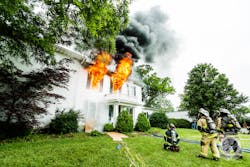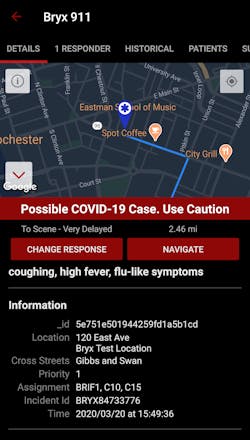Firehouse Station Design Awards: Call for Entries
Firehouse Magazine is seeking entries for its seventh-annual Station Design Awards, which recognizes architects and fire departments for their achievements in fire station design and construction.
The Station Design Awards identify trends and educate Firehouse Magazine readers using examples of new public safety facilities that are designed and constructed to meet the needs and responsibilities of an agency, to ensure the safety of its personnel and to serve the community.
The Awards will recognize work in the following categories:
- Career Stations I—15,000-sq.-ft. or larger facilities that are staffed by full-time fire and emergency personnel;
- Career Stations II—Facilities that are smaller than 15,000 square feet that are staffed by full-time fire/emergency personnel;
- Satellite Stations—Additional stations from headquarters or main offices;
- Volunteer/Combination Stations—Facilities that are staffed by fully volunteer or a combination of nonpaid and paid fire and emergency personnel;
- Shared Facilities—Fire and emergency response facilities that are shared with other agencies or organizations, such as police, local government offices or a library;
- Station Renovation—Facilities that are redesigned, re-purposed or upgraded; and
- Training Facilities—Designated fire and emergency response facilities for training.
Projects must have been completed after Jan. 1, 2016. Judges have requested only completed projects be submitted, as renderings are subject to change during approvals, budget adjustments and final construction.
The deadline for entries is July 28. Entries will appear in the November issue of Firehouse Magazine.
For more details and entry forms, visit Firehouse.com/2020sda. Questions? Contact [email protected].
UL FSRI Report Stresses Coordination in Suppression and Ventilation Operations
The UL Firefighter Safety Research Institute (UL FSRI) released a new research report that’s titled Analysis of the Coordination of Suppression and Ventilation in Single-Family Homes, which is based on the first series of experiments that were conducted as part of the Study of Coordinated Fire Attack Utilizing Acquired Structures. This project was funded by the U.S. Department of Homeland Security and FEMA’s Assistance to Firefighters Grant Program.
The purpose of this study is to increase fire service knowledge of fire dynamics and the effect of firefighting tactics through a better understanding of how suppression and ventilation are coordinated on the fireground in acquired residential structures. Specifically, the goal is to better understand the science that’s behind fire attack coordination and how firefighting tactics might link together to create a positive outcome for occupant survivability, firefighter safety and property conservation.In conjunction with the fire service project technical panel, UL FSRI engineers developed and conducted a series of 20 experiments that were designed to evaluate fire control strategies for both second-floor bedroom fires (14 experiments) and first-floor kitchen fires (six experiments). These acquired structure experiments were conducted in collaboration with the Sidney, OH, Fire Department and the Beavercreek Township, OH, Fire Department.
Utilizing eight single-family homes, these experiments brought the laboratory to the street. Tactics tested included horizontal, vertical and positive-pressure ventilation combined with interior or interior/exterior suppression. Through its partnership with the Illinois Fire Service Institute, UL FSRI also looked to better understand firefighter and occupant exposure and the correlation to the coordination of firefighting tactics.
The report provides fire dynamics analysis of each of the experiments, a discussion of the different control strategies that were examined and tactical considerations that were developed with the project technical panel.
“It’s very important for us to be able to have fire service partners, such as the Sidney and Beavercreek Township Fire Departments, that allow us to do these experiments outside of the lab,” said Stephen Kerber, who is UL FSRI’s vice president of research. “Without their support, we would not have been able to get these structures and conduct this research. We could not have done this on our own. Since the UL FSRI team returned from the experiments in Ohio, they have been pouring through data and video, working with our technical panel and preparing the results to hit the street, so this research can have the greatest impact on firefighter safety and effectiveness.”
Two more reports, which focus on the multifamily residential and commercial structure experiments that were conducted for this study, will follow. Additionally, online courses are being developed and will be available through the UL FSRI Fire Safety Academy.
For more information and to access the report, visit ulfirefightersafety.org.
Bryx Offers COVID-19 Warning Banner for First Responders
Bryx launched a new COVID-19 Critical Warning banner within its free Bryx 911 mobile alerting application. Keywords that are associated with the virus are pulled systematically from supplemental data, triggering a banner that informs first responders of possible cases in which safety protocols and equipment might be necessary.The company’s unique algorithm, which is used to trigger the COVID-19 Critical Warning banner, can be extended to provide warnings for future emergencies that are based on other criteria. This new development stems from Bryx’s demonstrated commitment to providing first responders with a wealth of information—improving not only the preparedness of first responders but the well-being and safety of both first responders and the community at large.
For more information, visit bryx.com.
Line-of-Duty Deaths
4 U.S. firefighters recently died in the line of duty. Two firefighters died during fireground operations, one died in a motor-vehicle accident and one death was health-related.
SAFETY OFFICER JOE J. TUCKER, JR., 62, of the Thoroughfare Volunteer Fire Department in Goldsboro, NC, died on March 8. Tucker complained to co-workers that he wasn’t feeling well before driving the department’s engine to a structure fire. After arriving on scene, Tucker immediately was transported to the Wayne UNC Health Care, where he passed away.
FIREFIGHTER JEROME GUISE, 34, of Citizen’s Fire Company No. 1 of Mt. Holly Springs, PA, died on March 9. While battling a fire at a single-family home in Monroe Township, Guise was fatally injured when the structure’s heavy timber front porch roof collapsed on top of him. He was pronounced deceased on scene.
FIREFIGHTER BENJAMEN “BEN” LAUREN, 23, of the Forsyth Township Fire Department in Gwinn, MI, died on March 13. Lauren arrived at the scene of a duplex fire and worked the interior of the structure. Part of the floor collapsed, which caused Lauren to become trapped between the first floor and the basement. He was pronounced deceased on scene. An investigation into the cause of the fire is under investigation.
FIREFIGHTER ZACHARY S. BLANKENSHIP, 26, of the Montcalm, WV, Volunteer Fire Department, died on March 15. Blankenship responded to a fire at a residential structure on March 5. Upon returning home, he collapsed. Blankenship was taken immediately to the Bluefield Regional Medical Center, where it was determined that he suffered a stroke. He later was flown to a hospital in Roanoke, VA, but died 10 days after the initial incident.
About the Author
Firehouse Staff
Content written and created by Firehouse Magazine editors.


